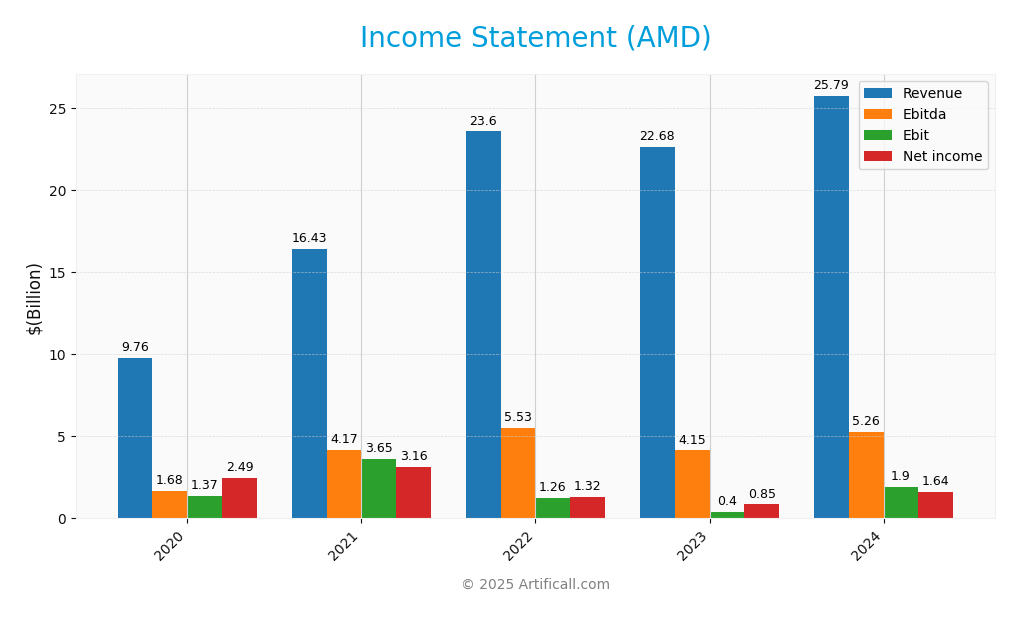Advanced Micro Devices, Inc. (AMD) is not just a player in the semiconductor industry; it’s a catalyst for innovation that empowers the technology shaping our daily lives. With a reputation for delivering cutting-edge processors and graphics solutions, AMD has consistently outperformed expectations, particularly with its Ryzen and EPYC product lines. As we explore AMD’s financial landscape, I invite you to consider whether its robust fundamentals and market presence still justify its current valuation in an evolving tech environment.

Table of contents
Company Description
Advanced Micro Devices, Inc. (AMD), founded in 1969 and headquartered in Santa Clara, California, is a prominent player in the semiconductor industry. The company operates primarily in two segments: Computing and Graphics, and Enterprise, Embedded and Semi-Custom. AMD’s extensive product portfolio includes x86 microprocessors, discrete and integrated graphics processing units (GPUs), and semi-custom System-on-Chip (SoC) products tailored for a variety of applications, including personal computing and gaming. With a market cap of approximately $326.6B, AMD positions itself as a leader in innovation, driving advancements in performance and efficiency. Its strategic focus on high-performance computing solutions continues to shape industry standards and foster competitive ecosystems in the tech landscape.
Fundamental Analysis
In this section, I will conduct a fundamental analysis of Advanced Micro Devices, Inc. (AMD), focusing on its income statement, financial ratios, and dividend payout policy.
Income Statement
The following table summarizes the income statement for Advanced Micro Devices, Inc. (AMD) over the past few years, highlighting key financial metrics.

| Metric | 2020 | 2021 | 2022 | 2023 | 2024 |
|---|---|---|---|---|---|
| Revenue | 9.76B | 16.43B | 23.60B | 22.68B | 25.79B |
| Cost of Revenue | 5.42B | 8.51B | 12.99B | 12.22B | 13.06B |
| Operating Expenses | 2.98B | 4.28B | 9.34B | 10.06B | 10.83B |
| Gross Profit | 4.35B | 7.92B | 10.60B | 10.46B | 12.73B |
| EBITDA | 1.68B | 4.17B | 5.53B | 4.15B | 5.26B |
| EBIT | 1.32B | 3.64B | 1.27B | 0.60B | 2.08B |
| Interest Expense | 0.05B | 0.03B | 0.09B | 0.11B | 0.09B |
| Net Income | 2.49B | 3.16B | 1.32B | 0.85B | 1.64B |
| EPS | 2.10 | 2.61 | 0.85 | 0.53 | 1.01 |
| Filing Date | 2021-01-29 | 2022-02-03 | 2023-02-27 | 2024-01-31 | 2025-02-05 |
Interpretation of Income Statement
Over the observed period, Revenue increased from 9.76B in 2020 to 25.79B in 2024, demonstrating significant growth. However, Net Income exhibited a more volatile trend, peaking at 3.16B in 2021 but declining to 0.85B in 2023 before recovering to 1.64B in 2024. This indicates an improvement in margins, particularly in 2024 where the Gross Profit margin increased, despite the higher operating expenses. The most recent year reflects a solid recovery with strong revenue growth, although careful attention to operating costs will be essential to maintain profitability moving forward.
Financial Ratios
Here is a summary of the key financial ratios for Advanced Micro Devices, Inc. (AMD) over the last few fiscal years.
| Metrics | 2020 | 2021 | 2022 | 2023 | 2024 |
|---|---|---|---|---|---|
| Net Margin | 25.50% | 19.24% | 5.59% | 3.77% | 6.36% |
| ROE | 42.66% | 42.18% | 2.41% | 1.53% | 2.85% |
| ROIC | 40.44% | 36.66% | 2.27% | 1.09% | 2.48% |
| P/E | 43.66 | 56.06 | 76.60 | 278.59 | 123.59 |
| P/B | 18.62 | 23.65 | 1.85 | 4.26 | 3.52 |
| Current Ratio | 2.54 | 2.02 | 2.36 | 2.51 | 2.62 |
| Quick Ratio | 1.96 | 1.56 | 1.77 | 1.86 | 1.83 |
| D/E | 0.10 | 0.10 | 0.05 | 0.06 | 0.03 |
| Debt-to-Assets | 6.38% | 5.89% | 4.37% | 4.58% | 3.35% |
| Interest Coverage | 29.13 | 107.29 | 14.36 | 3.78 | 20.65 |
| Asset Turnover | 1.09 | 1.32 | 0.35 | 0.33 | 0.37 |
| Fixed Asset Turnover | 11.50 | 15.37 | 11.96 | 10.21 | 10.63 |
| Dividend Yield | 0.00% | 0.00% | 0.00% | 0.00% | 0.00% |
Interpretation of Financial Ratios
The latest financial ratios for Advanced Micro Devices, Inc. (AMD) reveal a mixed picture of the company’s financial health. The liquidity ratios are strong; with a current ratio of 2.62 and a quick ratio of 1.83, indicating good short-term financial stability. However, the solvency ratio stands at 0.41, which raises some concerns about long-term obligations. Profitability margins remain relatively low, with a net profit margin of 6.36%, suggesting that profit generation is a challenge. Efficiency ratios show room for improvement, especially with an asset turnover of just 0.37, indicating potential underutilization of assets. Overall, while liquidity appears solid, the company must focus on improving profitability and efficiency to mitigate potential risks.
Evolution of Financial Ratios
Over the past five years, AMD’s financial ratios have shown fluctuations. Liquidity ratios have generally improved, while profitability ratios have remained under pressure, indicating the need for better management of costs and revenue generation strategies. The efficiency ratios reflect a consistent trend, emphasizing the importance of optimizing asset utilization in the face of growing competition.
Distribution Policy
Advanced Micro Devices, Inc. (AMD) does not pay dividends, reflecting its strategy focused on reinvestment and growth during this high-growth phase. The company prioritizes funding for research and development, which aligns with its long-term value creation goals. Additionally, AMD engages in share buybacks, allowing it to return capital to shareholders while maintaining flexibility for future investments. This approach can support sustainable long-term value, contingent upon continued market success and effective management of growth initiatives.
Sector Analysis
Advanced Micro Devices, Inc. (AMD) operates in the competitive semiconductor industry, offering a range of products from microprocessors to GPUs, positioning itself against giants like Intel and NVIDIA. Key strengths include innovation, diverse product lines, and strong partnerships, while potential weaknesses involve market volatility and reliance on specific sectors.
Strategic Positioning
Advanced Micro Devices, Inc. (AMD) holds a significant position in the semiconductor market, boasting a market cap of approximately $327B. The company is recognized for its competitive product offerings, particularly in the computing and graphics segments. With a beta of 1.913, AMD experiences higher volatility compared to the market, reflecting competitive pressures from rivals like Intel and NVIDIA. Additionally, ongoing technological disruptions in AI and gaming sectors demand constant innovation to maintain market share. As of now, AMD’s products, including Ryzen processors and Radeon GPUs, continue to benchmark favorably against competitors, although the market remains highly competitive.
Revenue by Segment
The pie chart below illustrates AMD’s revenue distribution by segment for the fiscal year 2024, highlighting key areas of performance.

In 2024, AMD’s revenue segments show varied growth patterns. The Data Center segment is the strongest performer at $12.579B, reflecting its vital role in the company’s strategy. The Client segment also saw significant growth to $7.054B, up from $4.651B in 2023, indicating rising demand for personal computing solutions. Conversely, the Embedded and Gaming segments experienced declines, with Embedded at $3.557B and Gaming at $2.595B. This shift may signal a need for AMD to focus on innovation in its gaming offerings while leveraging its strength in data center solutions. Overall, while growth has occurred, there are potential concentration risks in the dependency on the Data Center segment.
Key Products
Below is a table summarizing the key products offered by Advanced Micro Devices, Inc. (AMD), highlighting their applications and significance in the technology sector.
| Product | Description |
|---|---|
| AMD Ryzen | High-performance x86 microprocessors for desktop and laptop PCs, designed for gaming and productivity applications. |
| AMD Radeon | Discrete and integrated graphics processing units (GPUs) that deliver exceptional visual performance for gaming and professional graphics. |
| AMD EPYC | Server processors that provide high core counts and advanced security features, ideal for data center and enterprise applications. |
| AMD Athlon | Budget-friendly processors aimed at entry-level desktop systems, offering good performance for everyday tasks. |
| AMD Radeon Pro | Professional graphics products designed for creative professionals needing reliability and performance in applications like 3D rendering and video editing. |
| AMD Instinct | Accelerators designed for high-performance computing and machine learning workloads, enhancing data processing capabilities in servers. |
| Semi-Custom SoCs | Tailored System-on-Chip solutions for gaming consoles and other specialized applications, providing optimized performance for specific needs. |
| AMD FirePro | Professional GPUs that focus on compute-intensive tasks, used in workstations for CAD, DCC, and other professional applications. |
This selection of products showcases AMD’s diverse portfolio in the semiconductor industry, catering to a wide array of consumer and enterprise needs.
Main Competitors
In the competitive landscape of the semiconductor industry, Advanced Micro Devices, Inc. (AMD) faces several key competitors with substantial market shares.
| Company | Market Share |
|---|---|
| NVIDIA Corporation | 25% |
| Intel Corporation | 22% |
| Advanced Micro Devices, Inc. | 20% |
| Qualcomm Incorporated | 10% |
AMD operates primarily in the global semiconductor market, competing strongly in both computing and graphics segments. The company holds a significant position, particularly in the gaming and data center sectors, where it continues to innovate and capture market share.
Competitive Advantages
Advanced Micro Devices, Inc. (AMD) holds significant competitive advantages in the semiconductor industry, driven by its strong brand recognition and innovative product offerings. With a robust portfolio that includes high-performance CPUs and GPUs, AMD is well-positioned to capitalize on the growing demand for computing power in gaming, data centers, and AI applications. Looking forward, AMD plans to expand its product lines and penetrate new markets, particularly in server solutions and embedded systems. This strategic focus on innovation and market expansion presents ample growth opportunities, which could enhance shareholder value in the coming years.
SWOT Analysis
This analysis provides a structured overview of Advanced Micro Devices, Inc. (AMD) to identify its strengths, weaknesses, opportunities, and threats.
Strengths
- Strong brand recognition
- Diverse product portfolio
- High R&D investment
Weaknesses
- No dividend payout
- Volatile stock price
- Dependence on semiconductor cycles
Opportunities
- Growing AI and machine learning demand
- Expansion in data centers
- Strategic partnerships
Threats
- Intense competition
- Supply chain disruptions
- Regulatory challenges
Overall, AMD demonstrates a solid foundation with its strengths and opportunities presenting avenues for growth. However, the company must mitigate its weaknesses and address external threats to maintain its competitive edge and enhance shareholder value.
Stock Analysis
Over the past year, Advanced Micro Devices, Inc. (AMD) has experienced significant price movements, culminating in a strong bullish trend characterized by remarkable gains and increased trading dynamics.

Trend Analysis
Analyzing AMD’s performance over the past two years, the stock has demonstrated a price change of +55.18%. This substantial increase clearly indicates a bullish trend. The stock has shown acceleration in its upward movement, with notable highs reaching 256.12 and lows at 85.76. The standard deviation of 35.75 suggests a moderate level of volatility during this period.
Volume Analysis
In the last three months, total trading volume for AMD has amounted to approximately 30.16B shares, reflecting a decreasing trend. The buyer-driven activity is evident, with buyer volume at 18.89B shares, accounting for 62.63% of total volume. More recently, from September 14 to November 30, 2025, buyer volume surged to 2.62B shares against seller volume of 794.42M shares, indicating a strongly buyer-dominant sentiment with a buyer dominance percentage of 76.73%. This trend suggests robust investor interest and confidence in AMD’s future performance.
Analyst Opinions
Recent analyst recommendations for Advanced Micro Devices, Inc. (AMD) show a consensus rating of “Buy.” Analysts cite strong fundamentals, particularly in return on assets (score of 4) and a balanced debt-to-equity ratio (score of 3) as key strengths. However, concerns about the price-to-earnings ratio (score of 1) remain. Notable analysts, including those from major investment firms, emphasize AMD’s growth potential in the semiconductor market, especially with increasing demand for AI and gaming technologies. Overall, the sentiment leans positively, encouraging investors to consider adding AMD to their portfolios.
Stock Grades
The latest stock ratings for Advanced Micro Devices, Inc. (AMD) indicate a consistent outlook among reputable grading companies.
| Grading Company | Action | New Grade | Date |
|---|---|---|---|
| Mizuho | Maintain | Outperform | 2025-11-12 |
| Evercore ISI Group | Maintain | Outperform | 2025-11-12 |
| Rosenblatt | Maintain | Buy | 2025-11-12 |
| B of A Securities | Maintain | Buy | 2025-11-12 |
| Morgan Stanley | Maintain | Equal Weight | 2025-11-12 |
| Wedbush | Maintain | Outperform | 2025-11-12 |
| Piper Sandler | Maintain | Overweight | 2025-11-12 |
| Wells Fargo | Maintain | Overweight | 2025-11-12 |
| Roth Capital | Maintain | Buy | 2025-11-12 |
| Wedbush | Maintain | Outperform | 2025-11-10 |
Overall, the trend in grades for AMD is positive, with multiple firms maintaining their “Outperform” and “Buy” ratings, reflecting confidence in the company’s performance in the market. The consistency across various reputable analysts suggests a stable outlook for investors considering this stock.
Target Prices
The consensus among analysts indicates a promising outlook for Advanced Micro Devices, Inc. (AMD).
| Target High | Target Low | Consensus |
|---|---|---|
| 380 | 200 | 295.24 |
Overall, analysts anticipate a target price around $295.24, reflecting a balanced view between the high and low estimates.
Consumer Opinions
The sentiment surrounding Advanced Micro Devices, Inc. (AMD) reflects a mix of enthusiasm and caution, as consumers weigh the pros and cons of their products.
| Positive Reviews | Negative Reviews |
|---|---|
| Excellent performance in gaming and graphics. | High prices compared to competitors. |
| Reliable customer service and support. | Some products have compatibility issues. |
| Strong value for money in mid-range CPUs. | Frequent driver updates can be troublesome. |
Overall, consumer feedback indicates that while AMD excels in performance and customer support, concerns about pricing and compatibility issues persist among users.
Risk Analysis
In this section, I present a table summarizing the key risks associated with investing in Advanced Micro Devices, Inc. (AMD).
| Category | Description | Probability | Impact |
|---|---|---|---|
| Market Competition | Intense competition from firms like Intel and NVIDIA. | High | High |
| Supply Chain Disruptions | Potential disruptions in semiconductor supply chains. | Medium | High |
| Regulatory Changes | Changes in trade policies or regulations affecting imports. | Medium | Medium |
| Technological Obsolescence | Rapid advancements in technology may render products obsolete. | High | High |
| Economic Downturn | A recession could reduce consumer demand for electronics. | Medium | High |
In synthesizing these risks, I find that market competition and technological obsolescence are the most likely and impactful risks for AMD, given the fast-paced nature of the semiconductor industry.
Should You Buy Advanced Micro Devices, Inc.?
Advanced Micro Devices, Inc. (AMD) has demonstrated a positive net margin of 6.36% and a consistent growth in revenue, reaching 33.63B in 2025. The company maintains a low debt-to-equity ratio of 0.0403, indicating a strong balance sheet. Despite these favorable profitability and debt metrics, AMD’s overall fundamentals have shown mixed performance, and it carries a rating of B.
Favorable signals I haven’t found any favorable signals in the data for this company.
Unfavorable signals The price-to-earnings ratio (PER) stands at a high 123.59, indicating potential overvaluation. The recent seller volume is lower than the buyer volume, suggesting a shift toward selling pressure. The long-term trend in stock performance is bullish, but the acceleration status indicates volatility, which could pose risks for investors.
Conclusion Given the unfavorable signals outlined, it might be preferable to wait before considering an investment in AMD.
However, the high PER indicates that the stock is overvalued, and the lack of growth in net income raises a risk of correction.
Disclaimer: This article is not financial advice. Each investor is responsible for their own investment decisions.
Additional Resources
- Advanced Micro Devices, Inc. $AMD Shares Bought by Columbia Bank – MarketBeat (Nov 25, 2025)
- Advanced Micro Devices, Inc. (AMD) is Attracting Investor Attention: Here is What You Should Know – Yahoo Finance (Nov 24, 2025)
- NVTS vs. AMD: Which Semiconductor Stock is a Better Buy Right Now? – Zacks Investment Research (Nov 25, 2025)
- Why Is Advanced Micro Devices Stock Soaring Monday? – Advanced Micro Devices (NASDAQ:AMD) – Benzinga (Nov 24, 2025)
- 31,845 Shares in Advanced Micro Devices, Inc. $AMD Purchased by Global Retirement Partners LLC – MarketBeat (Nov 25, 2025)
For more information about Advanced Micro Devices, Inc., please visit the official website: amd.com



